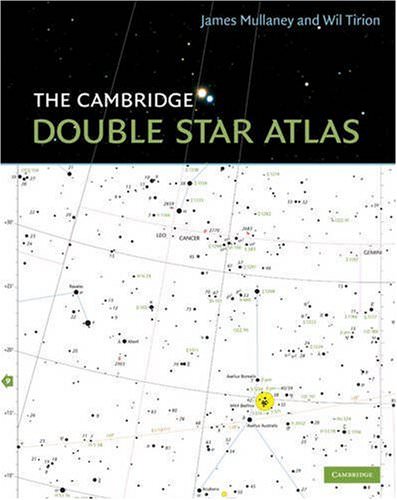[/caption]
Some of the best tourist discoveries occur off the beaten track. Plan to go somewhere, choose a fortuitous route and voila, a petite patch of paradise opens up in front of you. The same can be true for planning a night of star hunting. Dial coordinates into a ‘go-to’ satellite and you will immediately see your target, if all works well, but, you won’t see anything else. However, take “The Cambridge Double Star Atlas” by James Mullaney and Wil Tirion, then star-hop to your destination, and who knows what you will find.
By using this atlas, you should still easily find some choice targets. It’s a book aimed at the amateur astronomer and it well hits its mark. For starters, it’s in a very large format. Central to the book are 30 maps, each shown across two pages. These wonderfully laid out guideposts show the glow from the Milky Way equator, constellation boundaries, significant stars and, of course, the double stars themselves. And to ease the viewer along the way, many clusters, nebulae and galaxies also grace the pages. The typical but necessary coordinates surround the pages’ edges; right acension across the top and declanation along the sides. With this, and a red flashlight, star hopping should be a breeze.
The book also has a sampling of 133 of what the authors consider showpiece double and multiple stars. Hence with this, the reader can start by choosing a target, learning about its discovery, determine where it is shown in the atlas and then setup the hops to get the wonder into the eyepiece. And with descriptions like the “Easter Egg” double, seen as strking yellow and ruddy-purple or garnet jewels, the reader will quickly fall into the joy of viewing the variety and splendor of the night time spectacle.
Two final sections round out this great atlas. The first is a brief introductory section that shares the particular pleasures of viewing multiple star systems. Then, in Appendix C, there’s a listing of the Cambridge Double Start Atlas target list. These presumably include all the nearly 2,400 double and multpile stars of the nearly 25,000 stars plotted on the 30 maps. Most of these are purported to be viewable with typical “backyard” telescopes in the 2-inch to 4-inch range, so there’s no need to worry about not being able to see most of them.
So whether you’re on a star-finding challenge or a personal quest for striking images, “The Cambridge Double Star Atlas” by James Mullaney and Wil Tirion is a fabulous resource. Well laid out, fully detailed and insightfully described, it has the details to get you where you want to go and perhaps place you beside many other fabulous, fortuitous views.


will i be able to “see” something with this atlas and the Galileoscope??
Given James Mullaney’s long fascination with double stars coupled with Wil Tirion’s status as an celestial cartographic expert, this book has all the makings of a ‘modern’ classic.